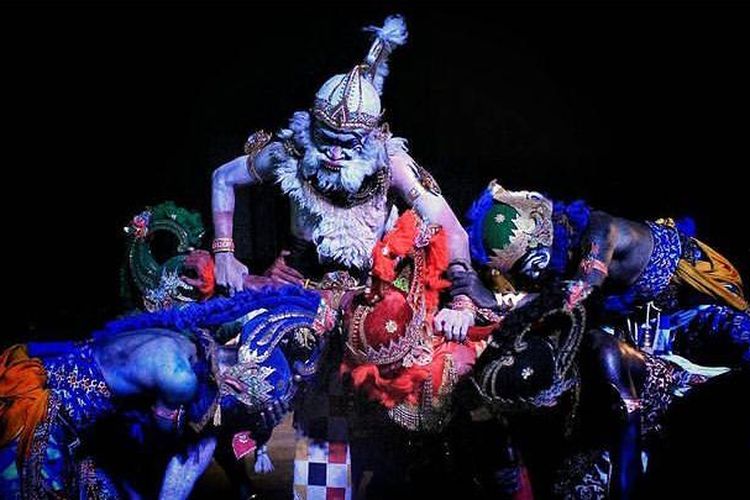Relevance of Ramayana in Indonesia
It is generally believed that Hinduism came to Indonesia in the first century through traders, sailors, scholars, and priests. It soon integrated into the preexisting Javanese traditions. Hinduism also adapted to Buddhism which arrived in Sumatra in the sixth century and this adaption evolved into an Indonesian version of Hinduism. However, with the demise of the Srivijaya and Majapahit empires, Hinduism weakened slowly in Indonesia.

Indonesian version of Ramayana: Kakawin Ramayana
The epic of Ramayana came to Indonesia around the 8th or 9th century. Written in the old Javanese language, it became known as the Kakawin Ramayana. It was used to revive Hinduism at a time when Buddhism was well established in Sumatra, West and Central Java through shadow puppetry (Wayang Kulit and Wayang Purwa). Stories from the Mahabharata have also been traced in some Indonesian islands to the 1st century and whose versions almost mirror the Indian version.

Ramayana Ballet, Yogyakarta (Photo: Google)
It is believed that the Kakawin Ramayana was written during the Medang Kingdom (732-1006 AD) in Central Java in the old Javanese language. The other Indonesian version of Ramayana is the Balinese Ramakavaca, which is a developed version of the Kakawin Ramayana.
The Javanese consider the Kakawin Ramayana, derived from an array of Sanskrit-based metrical patterns, as the pinnacle of artistic expression and remains the lengthiest of all Old Javanese texts. A large number of preserved palm leaf manuscripts of Java and Bali attest to its popularity and adaptation.
But the Kakawin Ramayana differs from the original Indian version in some ways. According to several literary scholars, the source of the old Javanese Kakawin Ramayana was possibly the Sanskrit poem Bhattikavya written by Indian poet Bhatti around the 7th century AD.
The first half of Kakawin Ramayana is almost identical to the rendering of Bhattikavya. But Indian scholars find that the latter half almost unrecognizable from the original. Though the characters of Rama, Sita, Lakshman, Hanuman, Ravan, etc remain fundamental to its narrative, the Kakawin Ramayana also has several Javanese indigenous deities like Dhayana, (regarded as the Guardian God of Java Semar or ‘Twalen’ in Balinese literature). However, these characters are most popular and figure prominently in all Wayang performances.
A significant difference however is how Sita is depicted. While the Indian Ramayana paints her as a soft, beautiful, demure, loyal, and patient woman, Kakawin Ramayana portrays her as bold, strong, and is seen fighting with Asuras in Ravana’s Lanka instead of waiting for Rama to rescue her.
It is not uncommon in Indonesian Wayang performances to see Sita’s character being played with her chin and head up in a defiant position. She is portrayed as a bit weak for desiring the golden deer, while Rama is shown as a bit imperfect since he trusted people over Sita after she was rescued from Lanka.

Hanuman is a much-revered character in Indonesia as he figures in many of the historic dance and drama artworks such as Wayang Wong found in Javanese culture and Odalan celebrations and other festivals in Bali. In many medieval era Hindu temples, archeological sites, and manuscripts discovered in Indonesia, Hanuman features prominently along with Rama, Sita, Lakshmana, Vishvamitra, and Sugriva.
 (Kompass.com)
(Kompass.com)Ramayana is such an ingrained aspect of Indonesian culture, especially among Javanese, Balinese and Sundanese people, that it has represented a source of moral and spiritual guidance as well as an aesthetic expression, especially through Wayang and traditional dances.
The Ramayana-based Wayang puppetry also ensured that the epics of Ramayana and Mahabharata became embedded in the cultural matrix of Indonesia. The prominent puppet theatres in Indonesia – Wayang Golek (wooden rod-puppet play) of the Sundanese and the Wayang Kulit (leather shadow-puppet play) of the Javanese and Balinese—draw much of their repertoire from indigenized versions of Ramayana and Mahabharata. It also provides source material for the Wayang Wong (human theatre) of Java and Bali. Although the vast majority of Javanese are Muslims, these art forms still survive and are a great source of entertainment.
The Balinese Kecak dance delineates the Ramayana saga, with dancers donning the roles of Rama, Sita, Laxmana, Jatayu, Hanuman, Ravana, and other characters. The performance also has a fire show depicting the burning of Lanka by Hanuman. Similarly in Yogyakarta, the Wayang Wong Javanese dance retells Ramayana through the famous Ramayana Ballet performed on the Trimurti Prambanan open-air stage, with the renowned Prambanan temple as the backdrop.

Ramayana Ballet (Photo: Google)
Bali is the perfect example of the living legend of Ramayana in Indonesia. One can see ornate and exquisite statues of Arjuna with his bow, Rama, Hanuman, Sita, Shiva, Jatayu, Vishnu, etc literally at every nook, corner, and roundabouts in Bali city.

Rama Statue in Bali (Photo: Google)
Though being a minority religion, Hinduism has influenced the way of life in Indonesia. Aside from theatre plays, books, stories & artworks depicting Ramayana, Indonesia has issued many Ramayana post stamps on Rama, Sita, and Hanuman, to date.
For many Indonesians, the legend of Ramayana is part of their culture and goes beyond the barriers of religion and ethnicity. They have not merely romanticized the idea of Ramayana but also approached it as a philosophy of life that is integral to daily living. To them Rama and Sita are not just heroes but torchbearers of good values, bringing relevance to modern-day living.
Former President of United States Barack Obama once famously mentioned that he had a special place for India in his imagination and the reason cited was that while living in Indonesia, he was often told the story of the Ramayana and Mahabharata, which seems to somewhat reinforce the connect these tales have to daily Indonesian life.
The older generation still reminds the new generation that before they get charmed by western superheroes like spiderman or batman, they should not forget Rama, Sita, and Hanuman. Younger generation Indonesians are now learning that they too are a part of a rich and ancient Hindu culture which gave them Ramayana and Mahabharata.






Comments
Post a Comment